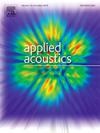Experimental observation of reflected acoustic beam tilting with temperature in quasi-collinear acousto-optic filters
IF 3.4
2区 物理与天体物理
Q1 ACOUSTICS
引用次数: 0
Abstract
This paper is devoted to the experimental investigation of temperature influence on the acoustic beam reflection in quasi-collinear acousto-optic (AO) tunable filters, fabricated on the base of paratellurite crystal. Such AO devices apply acoustic beam reflection from the input optical facet in such a way that the reflected beam Poynting vector is collinear to the incident optical radiation wave vector. This allows achieving abnormally high AO interaction length and consequently both high diffraction efficiency and spectral resolution and to realize the multi-frequency diffraction applied for ultrashort laser pulse spectrum and phase control. Due to the acoustic power absorption, the significant heating of AO crystal near the reflecting facet is observed.
The crystal heating affects the acoustic beam reflection condition through the ultrasound velocity variation and causes the reflected beam tilt from the initially chosen direction. The original method of reflected ultrasound beam structure measurement is proposed. The acoustic beams were visualized for various temperatures in two different quasi-collinear AO filters.
The temperature variation range typical for the quasi-collinear AO filters in multi-frequency operation causes the beam tilt of about 1-2 degrees, depending on the reflection geometry. The beam tilt influence on the quasi-collinear AO filter transmission functions was also studied. It is shown that the observed tilt significantly affects both the AO diffraction efficiency and the transmission functions, changing their shape and bandwidth.

本文致力于实验研究温度对准共线声光(AO)可调谐滤波器中声束反射的影响,这种滤波器是在准共线晶体的基础上制造的。这种 AO 设备从输入光学面进行声束反射,反射光束的 Poynting 向量与入射光辐射波向量平行。这样就能获得异常高的 AO 相互作用长度,从而获得高衍射效率和光谱分辨率,并实现用于超短激光脉冲光谱和相位控制的多频衍射。由于声功率的吸收,反射面附近的 AO 晶体会显著发热,晶体发热会通过超声波速度的变化影响声束的反射条件,导致反射波束从最初选择的方向倾斜。提出了测量反射超声波束结构的新方法。在两个不同的准共振 AO 滤波器中,对不同温度下的声束进行了可视化测量。在多频工作中,准共振 AO 滤波器的典型温度变化范围会导致声束倾斜约 1-2 度,具体取决于反射几何形状。此外,还研究了光束倾斜对准线性 AO 滤波器传输函数的影响。结果表明,观测到的光束倾斜会显著影响 AO 衍射效率和传输函数,改变它们的形状和带宽。
本文章由计算机程序翻译,如有差异,请以英文原文为准。
求助全文
约1分钟内获得全文
求助全文
来源期刊

Applied Acoustics
物理-声学
CiteScore
7.40
自引率
11.80%
发文量
618
审稿时长
7.5 months
期刊介绍:
Since its launch in 1968, Applied Acoustics has been publishing high quality research papers providing state-of-the-art coverage of research findings for engineers and scientists involved in applications of acoustics in the widest sense.
Applied Acoustics looks not only at recent developments in the understanding of acoustics but also at ways of exploiting that understanding. The Journal aims to encourage the exchange of practical experience through publication and in so doing creates a fund of technological information that can be used for solving related problems. The presentation of information in graphical or tabular form is especially encouraged. If a report of a mathematical development is a necessary part of a paper it is important to ensure that it is there only as an integral part of a practical solution to a problem and is supported by data. Applied Acoustics encourages the exchange of practical experience in the following ways: • Complete Papers • Short Technical Notes • Review Articles; and thereby provides a wealth of technological information that can be used to solve related problems.
Manuscripts that address all fields of applications of acoustics ranging from medicine and NDT to the environment and buildings are welcome.
 求助内容:
求助内容: 应助结果提醒方式:
应助结果提醒方式:


